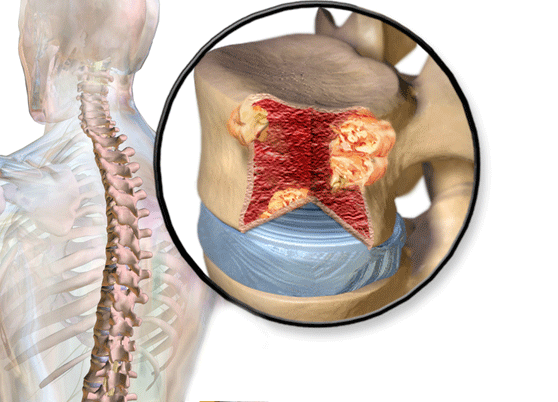Cancer is a disease in which some of the body’s cells grow uncontrollably and spread to other parts of the body. An abnormal cell growth in the spinal canal or the vertebrae of the spine that leads to a malignant tumor is called spine cancer.
A column of nerve tissue, which is called spinal cord, extends from the base of the brain down the back and is surrounded by three protective membranes. This cord is actually a part of central nervous system or CNS. The cells within the CNS usually divide and grow in an orderly and controlled way. But if it gets out of control, the cells keep dividing and form a tumor. There are two types of tumors which are either benign or malignant. A benign tumor keeps growing but is not cancerous and can’t spread to other parts of the body. A malignant tumor is cancerous and the cells can grow into and destroy surrounding tissue. They can also spread to other parts of the CNS.

Different types of spine cancer
There are two types of spinal cancers:
- Primary spine cancer
Which develops within the spine column.
- Secondary spine cancer or metastatic cancer
Which comes from cancerous vertebral tumors (in the vertebrae). Cancer usually spreads to the vertebrae from another part of the body, such as the breast, prostate or kidney
Tumors
Spinal cord tumors
- Intramedullary tumors: There are tumors that can be found within the spinal cord which are called intramedullary tumors and their most common types are astrocytoma and ependymomas. There might be the possibility to have an intramedullary tumor that has metastasized from a malignant tumor from another part of the body.
- Intradural extramedullary tumors: These tumors start inside the coverings of the spinal cord, but outside the cord itself. The most common examples are meningioma and nerve-sheath tumors, such as schwannomas.
Vertebral tumors or extradural tumors
The meaning of extradural is “outside the spine’s dura”, which is the outer most layer of protective tissue around the spine. Noncancerous and cancerous vertebral tumors can both lead to serious damage. Cancerous vertebral tumors usually spread:
- to the spine from breast and lung cancers in women
- from prostate cancer in men.
Any vertebral tumor, cancerous or not, can end up with loss of sensation or movement in the area below the tumor. Permanent nerve damage is also possible. These tumors can lead to instability in the spine, fractures or spinal collapse that can damage the spinal cord and death from tumors that restrict the spinal cord.
What are the spinal cancer symptoms?
The symptoms can differ from person to person, based on the size of their tumor and other related reasons. However, the most noticeable symptom is pain. Specifically the pain that comes from the tumor’s location in the spinal column.
When the spinal cord is being pressed on by the tumor, symptoms may be shown by numbness or tingling in the arms or legs. Next common symptom is clumsiness, an unease from not knowing where the feet are, that may be experienced by spinal cancer patients. Spinal cancer symptoms may grow to include weakness, not being able to move the legs and, potentially, paralysis.
Other common signs of spinal tumors and vertebral cancer tumors may include:
- back pain
- neck pain
- arm and leg pain
- weakness in muscles
- numbness in the arms and legs
- Difficulty walking
- General loss of sensation
- Spinal deformities (hunchback)
- Paralysis to varying degrees
- Difficulty with urination
- Change in bowel habits (loss of bowel control)
- Pain or difficulty with standing.

How to diagnose spinal cancer
There are some tests and tools for diagnosing spinal cancer which include:
- Angiography
- Lumbar puncture or a spinal tap
- Magnetic resonance imaging (MRI)
- X-ray
- Nuclear medicine bone scan
- Computed tomography (CT) scan
- Positron emission tomography (PET)/CT scan
What are the treatments for spinal cancer?
The treatments for this cancer may include the following.
- Surgery
- Chemotherapy
- Interventional radiology
- Radiation therapy
- Targeted therapy
Treatments for spinal cancer can be widely different and they depend on factors such as the location and extent of the disease. You should know that that supporting your strength, stamina and nutritional balance throughout any kind of treatment is important to your recovery. That’s why the doctor that you choose is really important. A good doctor will find the best way to cure the cancer and also pays attention to your mental health. So if you want to get through the illness easier, we suggest you find the best health care provider.
Frequently asked questions
It is unclear what causes tumors to develop in the spinal cord or the membranes covering the spinal cord.
Spine cancer affects about 10,000 people a year. Based on statistics, about 90 percent of cancerous tumors of the spine are metastatic tumors. Metastatic tumors are the ones that are originated in another part of the body. However, some rare vertebral cancers originate in the vertebrae and are known as primary cancers.
Although there is no clear picture of any group of individuals more at risk for spinal cancer, statistics show that men are diagnosed with the disease at a slightly higher rate than women.
Having some hereditary diseases, a compromised immune system, previous radiation therapy or exposure to some chemicals can also increase the risk of developing spinal cancer.


